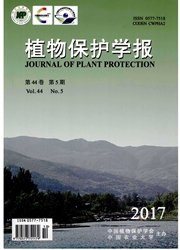

 中文摘要:
中文摘要:
为探索一种准确测定土壤根结线虫种群数量的方法,采用NaOCl消解附着在土壤病残体上的根结线虫卵囊与线虫常规离心技术相结合的方法,测试了不同NaOCl浓度、离心时间对根结线虫回收效率的影响,筛选出最佳测定条件,并与浅盘法、离心法、Byrd法等线虫常规分离方法进行了比较。结果表明,在9个NaOCl处理浓度中,1.0%~2.5%NaOCl处理对土壤根结线虫的回收效率显著高于3.0%NaOCl处理,达到71.6%~99.4%。在1.0%、1.5%、2.0%和2.5%NaOCl处理30 s后,分别离心2~5、2~3、2~3 min和2 min对根结线虫的回收效率明显高于其它时间处理,在每50 m L土壤平均接种976粒线虫卵的人工病土中,上述处理分离线虫数量分别达到804.3~930.0、810.7~838.7、843.7~867.0和820.7。本研究的改良方法对自然病土中根结线虫的分离数量分别是浅盘法、离心法和Byrd法的29.3、13.4和2.1倍,显著提高了土壤中根结线虫的分离效率,可准确测定土壤根结线虫种群的数量。
 英文摘要:
英文摘要:
To find a method for accurately estimating the number of root-knot nematodes( Meloidogyne spp.) in soil,the effects of sodium hypochlorite concentration and centrifugation time on the extracting efficacy for the nematodes were evaluated by using the method of dissolving gelatin of root-knot nematode egg masses with Na OCl combined with the traditional centrifugation method for the nematodes. The optimum extraction parameters were selected. The extraction efficacy for the new developed method was compared with those of shallow tray method,centrifugation method and Byrd method. The results showed that the extraction efficacies for Meloidogyne spp. with 1. 0%- 2. 5% sodium hypochlorite among nine treatments of different Na OCl concentrations were much higher than that with 3. 0% sodium hypochlorite.It reached to 71. 6%- 99. 4%. The extraction efficacies for the treatments by centrifugation for 2- 5,2- 3,2- 3 min and 2 min after treated with 1. 0%,1. 5%,2. 0% and 2. 5% sodium hypochlorite for30 s,respectively,were significantly higher than those for other sodium hypochlorite treatments. The numbers of nematodes extracted from 50 m L soil in which 976 eggs were inoculated were 804. 3- 930. 0,810. 7- 838. 7,843. 7- 867. 0 and 820. 7,respectively. The numbers of nematodes extracted from natural diseased soil with the developed method in this study was 29. 3,13. 4 and 2. 1 times of nematode numbers extracted by using shallow tray method,centrifugation method and Byrd method,respectively.The extraction efficacy was significantly increased. It could accurately estimate the number of root-knot nematodes in soil.
 同期刊论文项目
同期刊论文项目
 同项目期刊论文
同项目期刊论文
 期刊信息
期刊信息
